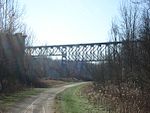Smithton, Pennsylvania
1901 establishments in PennsylvaniaBoroughs in Westmoreland County, PennsylvaniaPittsburgh metropolitan areaPopulated places established in 1901

Smithton is a borough in Westmoreland County, Pennsylvania, United States. The population was 399 at the 2010 census. As of 2018, the population was listed at 378. Smithton has its own post office, with zip code 15479, and is serviced by Yough School District.
Excerpt from the Wikipedia article Smithton, Pennsylvania (License: CC BY-SA 3.0, Authors, Images).Smithton, Pennsylvania
Locust,
Geographical coordinates (GPS) Address Nearby Places Show on map
Geographical coordinates (GPS)
| Latitude | Longitude |
|---|---|
| N 40.153888888889 ° | E -79.740555555556 ° |
Address
Locust
Locust
15479
Pennsylvania, United States
Open on Google Maps





